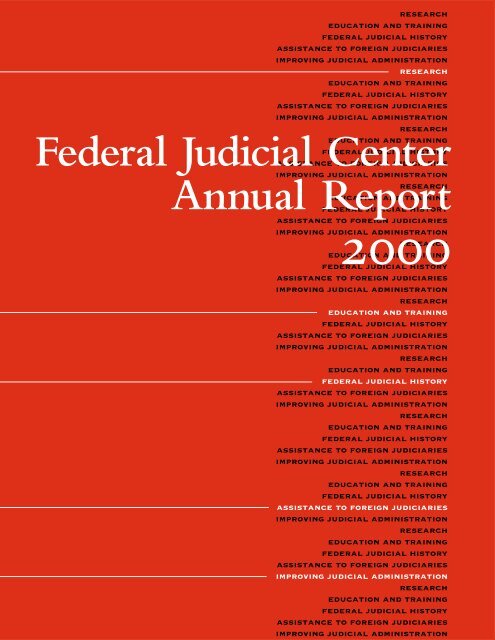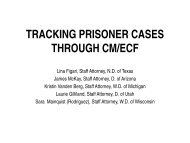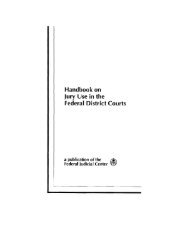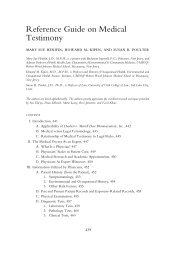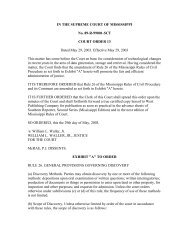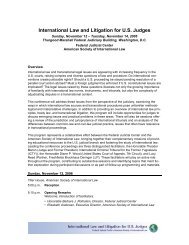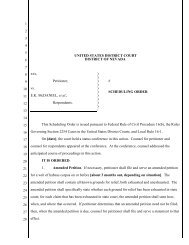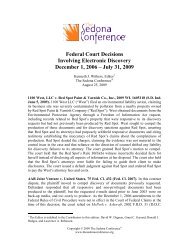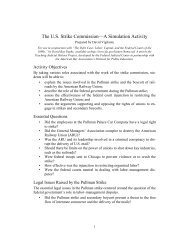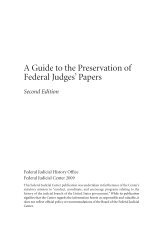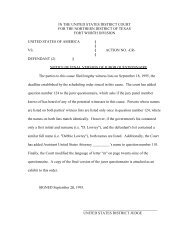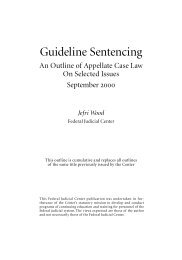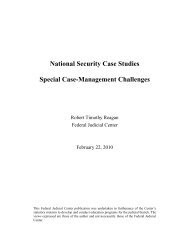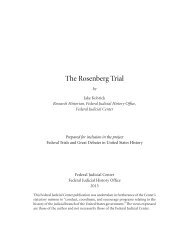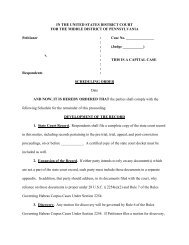Federal Judicial Center Annual Report 2000
Federal Judicial Center Annual Report 2000
Federal Judicial Center Annual Report 2000
Create successful ePaper yourself
Turn your PDF publications into a flip-book with our unique Google optimized e-Paper software.
esearch<br />
education and training<br />
federal judicial history<br />
assistance to foreign judiciaries<br />
improving judicial administration<br />
research<br />
education and training<br />
federal judicial history<br />
assistance to foreign judiciaries<br />
improving judicial administration<br />
research<br />
<strong>Federal</strong> <strong>Judicial</strong> <strong>Center</strong><br />
education and training<br />
federal judicial history<br />
assistance to foreign judiciaries<br />
improving judicial administration<br />
<strong>Annual</strong> <strong>Report</strong><br />
research<br />
education and training<br />
federal judicial history<br />
assistance to foreign judiciaries<br />
<strong>2000</strong><br />
improving judicial administration<br />
research<br />
education and training<br />
federal judicial history<br />
assistance to foreign judiciaries<br />
improving judicial administration<br />
research<br />
education and training<br />
federal judicial history<br />
assistance to foreign judiciaries<br />
improving judicial administration<br />
research<br />
education and training<br />
federal judicial history<br />
assistance to foreign judiciaries<br />
improving judicial administration<br />
research<br />
education and training<br />
federal judicial history<br />
assistance to foreign judiciaries<br />
improving judicial administration<br />
research<br />
education and training<br />
federal judicial history<br />
assistance to foreign judiciaries<br />
improving judicial administration<br />
research<br />
education and training<br />
federal judicial history<br />
assistance to foreign judiciaries<br />
improving judicial administration<br />
research<br />
education and training<br />
federal judicial history<br />
assistance to foreign judiciaries<br />
improving judicial administration
contents<br />
a message from the director: who we are and what we do, 1<br />
about the federal judicial center, 3<br />
Statutory mission, 3<br />
Governance, 3<br />
Organization, 3<br />
Coordination within the judicial branch, 4<br />
Staffing and appropriation, 5<br />
20 0 0 at a glance, 5<br />
e ducation & training, 6<br />
Education programs for judges and legal staff, 7<br />
Education &training programs for court staff, 8<br />
Distance education, 10<br />
Programs for foreign judicial officials, 12<br />
research, 13<br />
Appellate litigation, 13<br />
Bankruptcy litigation, 13<br />
Civil litigation, 13<br />
Criminal litigation, 14<br />
<strong>Federal</strong> judicial history, 14<br />
media programs & publications, 15<br />
Educational media programs, 15<br />
Publications, 16<br />
Information services, 17<br />
federal judicial center foundation, 18<br />
advisory committees, 19
A Message from the Director:<br />
Who We Are and What We Do<br />
The mission of the <strong>Federal</strong> <strong>Judicial</strong> <strong>Center</strong> is to educate federal judges and court<br />
staff and to contribute to the body of research that furthers judicial efficiency and<br />
promotes the rule of law. The <strong>Center</strong> was established in 1967 because Congress<br />
acknowledged that the business of judging had become so complicated that the<br />
judicial branch required an in-house agency dedicated primarily to the education<br />
of judges and court staff and conducting policy-oriented research. Newly appointed<br />
federal judges come from diverse professional backgrounds. Regardless of whether<br />
that background is criminal prosecution or defense, commercial litigation, civil<br />
rights, antitrust, or any other speciality, however, no judge arrives with experience<br />
in all of the substantive areas that make up a federal court docket. And few new<br />
judges, if any, are familiar with the multitude of procedural rules and tasks that are<br />
the daily fare on any federal judicial menu. So the <strong>Center</strong> introduces new judges<br />
to some of the demands of their new role.<br />
Our mandate does not stop with orientation, however; the need for judicial<br />
education is ongoing. New statutes are passed, new cases interpret those statutes,<br />
rules are amended, and some judges find innovative ways to do the job of judging<br />
better. Throughout our history, the <strong>Center</strong> has assisted judges in understanding<br />
and analyzing changes in such areas as civil rights, habeas corpus, securities law,<br />
antitrust, intellectual property, sentencing reform, rules governing evidence, class<br />
actions, and approaches to case management.<br />
So the changes keep coming—and not just new judges and new laws. Changes<br />
in other fields, such as science and technology, affect the courts, both in the issues<br />
litigated before them and in how the courts themselves operate. And the <strong>Center</strong><br />
responds accordingly, focusing not just on basic concepts, or on “what’s the latest,”<br />
but also on “what’s ahead.” Since our creation, the <strong>Center</strong> has provided<br />
federal judges with almost 1,000 separate seminars and conferences, as well as reference<br />
manuals and guides. More recently, we have complemented these programs<br />
with education through videos and direct satellite broadcasts. Pages 6 through<br />
12 of this report provide details on our offerings this year, for both judges and<br />
court personnel.<br />
That is who we are and what we do.<br />
In all of the <strong>Center</strong>’s judicial education programs, our main goal is to help<br />
judges familiarize themselves with the core elements of a subject and sift through<br />
the often conflicting points of view as to how they should assess and weigh facts<br />
and analyze legal doctrine. Part of our responsibility is to present competing points<br />
of view, in an intellectually sound but neutral way, so that judges are assured that<br />
<strong>2000</strong> annual report of the federal judicial center 1
they are getting a complete and unbiased analysis of complicated and often controversial<br />
issues. The Chief Justice put it well in his <strong>2000</strong> Year-End <strong>Report</strong> on the <strong>Federal</strong><br />
Judiciary:<br />
<strong>Federal</strong> judges today face cases involving complicated statutes and factual<br />
assertions, many of which straddle the intersections of law, technology, and<br />
the physical, biological and social sciences. FJC education programs and<br />
reference guides help judges sort out relevant facts and applicable law from<br />
the panoply of information with which the adversary system bombards them.<br />
The FJC thus contributes to the independent decision making that is the<br />
judge’s fundamental duty.<br />
About 15 percent of the 1,000 judicial education programs that the <strong>Center</strong> has<br />
presented have been undertaken in cooperation with other institutions, primarily<br />
law schools. This collaboration allows us to make maximum use of our limited<br />
funds, which have decreased in recent years, and leverage our own expertise. The<br />
<strong>Center</strong> retains control of program design in these joint ventures.<br />
The <strong>Center</strong>, of course, cannot be federal judges’ sole source of education and<br />
training, because the needs are too great and our resources too limited. Furthermore,<br />
the <strong>Center</strong>’s creation did not end the many ways in which judges learn both<br />
individually and through programs organized by their own courts, bench–bar groups,<br />
law schools, and others, particularly about matters distinctive to their own districts<br />
and states. Although there has been opposition to federal judges’ attendance at<br />
some privately sponsored seminars, the <strong>Center</strong> lays no claim that we have preempted<br />
the field of judicial education. In fact, last October, the <strong>Center</strong>’s Board<br />
unanimously opposed legislation, as did the <strong>Judicial</strong> Conference, that would have<br />
prohibited federal judges from attending any privately funded educational programs<br />
and would have allowed them to attend non-<strong>Center</strong> programs at government<br />
expense only if the <strong>Center</strong>’s Board approved of the program. It is not the<br />
<strong>Center</strong>’s role to decide which non-<strong>Center</strong> programs judges should attend.<br />
It is the <strong>Center</strong>’s role to provide judges with as many tools as our resources<br />
allow to assist them in resolving the difficult questions that confront them in delivering<br />
equal justice under law. The Chief Justice observed in his year-end statement<br />
that “our courts continue to serve as a standard of excellence around the<br />
world.” We are proud of the <strong>Center</strong>’s contributions to that excellence.<br />
Fern M. Smith<br />
2 <strong>2000</strong> annual report of the federal judicial center
About the <strong>Federal</strong> <strong>Judicial</strong> <strong>Center</strong><br />
statutory mission<br />
In 1967, Congress created the <strong>Federal</strong> <strong>Judicial</strong> <strong>Center</strong> “to further the development<br />
and adoption of improved judicial administration” in the courts of the United<br />
States. The <strong>Center</strong>’s statutory duties are codified at 28 U.S.C. §§ 620–629. They<br />
include providing orientation and continuing education for the judges and staff of<br />
the federal judicial system, performing research on court operations and procedures<br />
(particularly in support of <strong>Judicial</strong> Conference committees), and conducting<br />
programs to promote judicial federalism, assist foreign judicial systems, and study<br />
the federal courts’ history. This annual report, mandated by statute, describes the<br />
<strong>Center</strong>’s activities in furtherance of its statutory duties in calendar year <strong>2000</strong>.<br />
governance<br />
The Chief Justice of the United States chairs the <strong>Center</strong>’s Board, which also includes<br />
two circuit judges, three district judges, one bankruptcy judge, and one<br />
magistrate judge elected by the <strong>Judicial</strong> Conference, as well as the director of the<br />
Administrative Office of the U.S. Courts (ex officio). The Board oversees the FJC’s<br />
activities, and its members serve on standing committees on education and research<br />
and on advisory committees on judicial education programs.<br />
In March <strong>2000</strong>, the <strong>Judicial</strong> Conference elected Judge Pauline Newman of the<br />
U.S. Court of Appeals for the <strong>Federal</strong> Circuit and Judge Robert J. Bryan of the<br />
U.S. District Court for the Western District of Washington to membership on the<br />
Board. Judge Robert M. Parker of the U.S. Court of Appeals for the Fifth Circuit<br />
had resigned for reasons of health, and Judge Thomas F. Hogan of the U.S. District<br />
Court for the District of Columbia left the Board because his term expired.<br />
The Board appoints the FJC’s director and deputy director; the director appoints<br />
the <strong>Center</strong>’s staff. All but one of the <strong>Center</strong>’s eight directors have been<br />
federal judges, including the current director, Judge Fern M. Smith of the U.S.<br />
District Court for the Northern District of California.<br />
organization<br />
The organizational structure of the <strong>Center</strong> reflects its primary statutory mandates<br />
and direction provided in the Board’s 1997 strategic plan. The <strong>Judicial</strong> Education<br />
and Court Education divisions are responsible for planning and producing all education<br />
and training programs for judges and court staff, including satellite broadcasts,<br />
video programs, Web resources, and educational publications. The Research<br />
Division examines and evaluates current and alternative federal court practices and<br />
policies. This research not only assists committees of the <strong>Judicial</strong> Conference in<br />
developing policy recommendations but also contributes substantially to educational<br />
programs and products for the judiciary. The three divisions work closely<br />
with two units of the Director’s Office—the Systems Innovation & Development<br />
Office and Communications Policy & Design—in using print, broadcast, and on-<br />
<strong>2000</strong> annual report of the federal judicial center 3
line media to deliver timely education and training and to disseminate the results<br />
of <strong>Center</strong> research. The <strong>Federal</strong> <strong>Judicial</strong> History Office, a part of the Research<br />
Division, develops innovative ways to help courts and scholars study and preserve<br />
federal judicial history, including a Web site that was introduced in <strong>2000</strong>. The<br />
Interjudicial Affairs Office, part of the <strong>Judicial</strong> Education Division, provides information<br />
to judicial and legal officials from foreign countries and assesses how developments<br />
in international law should be included in the <strong>Center</strong>’s educational programs<br />
for federal judges.<br />
coordination within the judicial branch<br />
Numerous programs and projects described in this annual report involve coordination,<br />
cooperation, and consultation with the <strong>Judicial</strong> Conference and its committees,<br />
with the Administrative Office, and with the U.S. Sentencing Commission.<br />
At the request of the <strong>Center</strong>’s Board and the <strong>Judicial</strong> Conference, and pursuant<br />
to the <strong>Center</strong>’s strategic plan, the FJC and the Administrative Office have<br />
created an interagency committee to promote appropriate coordination of educational<br />
activities.<br />
In <strong>2000</strong>, at the request of Rep. Harold Rogers, chair of the House Appropriations<br />
Subcommittee on Commerce, Justice, State, the Judiciary, and Related Agencies,<br />
the <strong>Center</strong> and the Administrative Office prepared a paper describing the past<br />
and present uses of technology in the federal courts, as well as emerging technologies<br />
that might be applicable to court operations. Chairman Rogers had asked the<br />
senior staff of the federal judicial center<br />
Fern M. Smith, Director<br />
Russell R. Wheeler, Deputy Director<br />
John S. Cooke, Director, <strong>Judicial</strong> Education Division<br />
James B. Eaglin, Director, Research Division<br />
Emily Z. Huebner, Director, Court Education Division<br />
Sylvan A. Sobel, Director, Communications Policy & Design<br />
Ted E. Coleman, Chief, Systems Innovation & Development Office<br />
Mira Gur-Arie, Senior Attorney for Interjudicial Affairs<br />
Bruce A. Ragsdale, Chief, <strong>Federal</strong> <strong>Judicial</strong> History Office<br />
4 <strong>2000</strong> annual report of the federal judicial center
<strong>Center</strong> to describe how technology influences training and education in the federal<br />
judiciary and had asked the Administrative Office to report on how technology<br />
influences the administration and operations of the federal courts.<br />
Advisory committees of judges, court staff, and others help the <strong>Center</strong> in planning<br />
and producing education programs and publications. These committees are<br />
listed on pages 19 and 20.<br />
staffing and appropriation<br />
The <strong>Center</strong> had a fiscal <strong>2000</strong> appropriation of $17,932,000, and it employed 141<br />
people at the end of calendar year <strong>2000</strong>. Its fiscal 2001 appropriation is $18,736,000.<br />
<strong>2000</strong> at a Glance<br />
In <strong>2000</strong> the <strong>Center</strong><br />
• provided 728 educational programs (including educational programs broadcast<br />
on the <strong>Federal</strong> <strong>Judicial</strong> Television Network) for more than 48,000 federal<br />
judge and court staff participants<br />
• completed thirteen major research and evaluation projects, continued work<br />
on twenty-two others, and responded to many other requests for shortterm<br />
research assistance<br />
• published or updated seven manuals, monographs, or similar reference books<br />
and published five research reports<br />
• launched the History of the <strong>Federal</strong> Judiciary Web site on its Internet and<br />
intranet homepages, which presents for the first time anywhere information<br />
about the service records, careers, and education of the more than 2,800<br />
district and appellate judges and justices who have served since 1789<br />
• produced or updated seventy-one educational media programs for live or<br />
videotaped satellite broadcast or distribution on videocassette<br />
• broadcast more than 1,880 hours of educational and informational programs<br />
from the <strong>Center</strong>, the Sentencing Commission, and the Administrative Office<br />
on the <strong>Federal</strong> <strong>Judicial</strong> Television Network<br />
• completed six curriculum packages and training guides<br />
• released one computer-based instructional program<br />
• distributed more than 246,000 copies of its publications, including periodicals<br />
and catalogs of books, programs, and other services, as well as almost<br />
2,800 audio, video, and multimedia programs<br />
• answered approximately 2,000 information requests from judges, court staff,<br />
and others<br />
• hosted seminars or briefings for some 350 foreign judges and officials from<br />
forty countries<br />
<strong>2000</strong> annual report of the federal judicial center 5
Education & Training<br />
Judges and court staff receive education and training from the <strong>Center</strong> through a<br />
variety of methods. Face-to-face conferences, seminars, and workshops are often<br />
the best way to bring together participants from throughout the judicial system so<br />
that they can learn from one another. Such programs continue to be the primary<br />
vehicle for orientation and continuing education for judges; however, most of the<br />
staff of the courts who participate in <strong>Center</strong> education programs and in local training<br />
events do so through distance education. In <strong>2000</strong>, at least 88% of the participants<br />
in <strong>Center</strong> programs used <strong>Center</strong>-prepared curriculum packages in their own<br />
courts, watched satellite broadcasts on the <strong>Federal</strong> <strong>Judicial</strong> Television Network<br />
(FJTN), or participated in other forms of distance education. The <strong>Center</strong> also<br />
publishes manuals, monographs, and other job aids and produces audiotapes, videotapes,<br />
and computer-based educational media. Many of these resources are also<br />
available on the <strong>Center</strong>’s site on the judiciary’s intranet (http://jnet.fjc.dcn).<br />
The <strong>Center</strong>’s <strong>2000</strong> education and training programs reached more than 48,000<br />
participants, as described below. (Each participation by a judge or court employee<br />
is included in these totals, so some individuals are counted more than once.) Readers<br />
of previous annual reports may note that total participant figures have increased<br />
substantially. This increase occurred because figures for participation in <strong>Center</strong><br />
education programs include, for the first time, estimated figures for FJTN viewings,<br />
based on a study the <strong>Center</strong> began testing in 1999 that uses statistical sampling to<br />
estimate viewership. The pilot-test phase of the study was completed in June <strong>2000</strong>,<br />
and the study became fully operational in July. During the nine-month period<br />
from January to September <strong>2000</strong>, the first six months of which were during the<br />
project’s pilot phase, the <strong>Center</strong> estimates that some 24,000 viewers watched live<br />
and videotaped educational and informational programs broadcast by the <strong>Center</strong>;<br />
the large majority of these viewers were court staff.<br />
seminars & workshops for judges, jan. 1–dec. 31, <strong>2000</strong><br />
Number of Number of<br />
Programs Participants<br />
Orientations for newly appointed circuit judges 1 3<br />
Orientations for newly appointed district judges 3 78<br />
Orientations for newly appointed bankruptcy judges 2 16<br />
Orientations for newly appointed magistrate judges 3 58<br />
Conference for chief district judges 1 85<br />
Conference for chief bankruptcy judges 1 95<br />
Workshops for district and circuit judges 7 463<br />
National workshops for bankruptcy judges 3 262<br />
National workshops for magistrate judges 2 326<br />
Sentencing Policy Institute 1 152<br />
Special-focus workshops 11 399<br />
In-court seminars 15 201<br />
TOTAL 50 2,138<br />
6 <strong>2000</strong> annual report of the federal judicial center
The <strong>Center</strong> also held five programs for 810 federal defenders and staff.<br />
court staff education & training programs, jan. 1–dec. 31, <strong>2000</strong><br />
Seminars and Workshops Number of Number of<br />
(national and regional) Programs Participants<br />
Clerks of court and clerk’s office personnel 11 1,184<br />
Probation and pretrial services officers and personnel 17 887<br />
Personnel in several categories 15 796<br />
TOTAL 43 2,867<br />
In-court Programs (programs using <strong>Center</strong> curriculum packages, Number of Number of<br />
training guides, and computer-assisted intructional programs) Programs Participants<br />
Clerks of court and clerk’s office personnel 366 9,506<br />
Probation and pretrial services officers and personnel 112 7,482<br />
Personnel in several categories 45 913<br />
TOTAL 523 17,901<br />
Technology-based Programs (videoconferences, Number of Number of<br />
audioconferences, on-line conferences)* Programs Participants<br />
Clerks of court and clerk’s office personnel 6 231<br />
Probation and pretrial services officers 2 79<br />
Personnel in several categories 8 203<br />
TOTAL 16 513<br />
GRAND TOTAL 582 21,281<br />
*The <strong>Center</strong> also provides Web-based education and training programs on its site on the judiciary’s intranet,<br />
but does not maintain figures for their usage. For FJTN viewership, see text above.<br />
education programs for judges and legal staff<br />
The <strong>Center</strong> provides orientation and continuing education programs and materials<br />
for judges on many subjects and in a variety of forms.<br />
Programs that judges attend in person include orientation seminars for all new<br />
trial judges; national and circuit-based workshops for all judges, each of which<br />
provide updates and analysis on multiple topics; and seminars devoted to specific<br />
subjects, such as employment law, intellectual property, and case management.<br />
The latter programs are particularly popular; consistently more judges apply than<br />
can be accommodated. In <strong>2000</strong>, the <strong>Center</strong> organized a Conference for Border<br />
Courts (cosponsored by the Administrative Office) to help courts find solutions to<br />
the problems arising from the huge increase in criminal cases along the southwest<br />
border. Judges from the border courts, led by Chief Judge Carolyn Dineen King<br />
of the U.S. Court of Appeals for the Fifth Circuit, asked for this conference and<br />
were instrumental in planning it. A national Sentencing Policy Institute examined<br />
the operation of the federal sentencing guidelines. The institute was produced in<br />
cooperation with the Criminal Law Committee of the <strong>Judicial</strong> Conference of the<br />
United States, the <strong>Federal</strong> Bureau of Prisons, the Administrative Office, and the<br />
U.S. Sentencing Commission. The <strong>Center</strong> also conducted conferences for chief<br />
district judges and chief bankruptcy judges on court-management issues, such as<br />
budgeting and privacy concerns associated with the electronic availability of court<br />
<strong>2000</strong> annual report of the federal judicial center 7
ecords. A conference for chief circuit judges and circuit executives on the management<br />
and administrative responsibilities of chief judges helped the <strong>Center</strong> produce<br />
a template to assist each circuit in preparing its own chief judge’s deskbook.<br />
In <strong>2000</strong>, the <strong>Center</strong> published new editions of its Reference Manual on Scientific<br />
Evidence and Guideline Sentencing: An Outline of Appellate Case Law on Selected Topics<br />
and updated the Benchbook for U.S. District Court Judges. It also produced a new<br />
manual on case-management procedures in the federal courts of appeals. These<br />
publications are available in print and in electronic form on the <strong>Center</strong>’s site on<br />
the judiciary’s intranet at http://jnet.fjc.dcn. New manuals on alternative dispute<br />
resolution, visiting judge programs, and international insolvency, and an on-line<br />
compilation of materials designed to help judges handle federal death penalty cases,<br />
will be available in early 2001. <strong>Center</strong> staff continued to work with the Administrative<br />
Office on a civil litigation management manual, under the direction of the<br />
Court Administration and Case Management Committee of the <strong>Judicial</strong> Conference.<br />
(Many of these manuals and reference guides are described further on pages<br />
13 and 14.)<br />
<strong>Center</strong> educational broadcasts for judges on the FJTN included the fourth<br />
annual review of the Supreme Court’s term; analysis of recurring issues in federal<br />
death penalty cases; examination of the effects of the Supreme Court’s decision in<br />
Apprendi v. New Jersey on charging and sentencing in criminal cases; periodic updates<br />
in bankruptcy law; and a review of developments in Social Security law. In<br />
September the <strong>Center</strong> broadcast its orientation program for new judicial law clerks,<br />
along with overviews of federal jurisdiction and the organization and jurisdiction<br />
of bankruptcy courts.<br />
education &training programs for court staff<br />
The <strong>Center</strong> provides practical education and training programs on critical job<br />
responsibilities for court managers and staff, as well as programs on executive team<br />
development and strategic planning for judges and senior court managers. Much<br />
of this training is delivered through distance education programs.<br />
In <strong>2000</strong>, new FJTN broadcasts helped court staff learn how to manage issues<br />
that arise in capital cases and described effective practices for opening appellate<br />
cases and for working with multi-party cases. Fifteen broadcasts for probation and<br />
pretrial services officers included additions to the <strong>Center</strong>’s series of programs to<br />
help officers supervise offenders with substance abuse problems, as well as additions<br />
to the FJC–Sentencing Commission series on sentencing and guidelines issues.<br />
An FJTN broadcast introduced the new Supervisors’ Development Program,<br />
a self-directed curriculum that requires participants to complete ninety to ninetysix<br />
hours of training incorporating <strong>Center</strong> self-study materials, in-district training,<br />
and distance learning. Examples of other broadcasts for probation and pretrial services<br />
officers are a two-part program to help officers communicate with Spanishspeaking<br />
offenders, two new programs in the series on dealing with sex offenders,<br />
and a broadcast on implementing the Administrative Office’s Monograph 114,<br />
Criminal Monetary Penalties: A Guide to the Probation Officer’s Role. A program on<br />
8 <strong>2000</strong> annual report of the federal judicial center
techniques for helping offenders obtain education and employment, and thereby<br />
reducing the risk of recidivism, has encouraged several districts to develop employment<br />
programs and job fairs for offenders.<br />
The <strong>Center</strong>’s television magazine programs, Court to Court and Perspectives on<br />
Probation and Pretrial Services, continue to serve as clearinghouses of ideas, innovations,<br />
and information for courts to share. For example, the District of Maryland<br />
bankruptcy court used video clips from a Court to Court segment on case management/electronic<br />
case filing to prepare staff for upcoming automation changes. The<br />
Eastern District of Virginia adapted some of the financial disclosure and ethics<br />
materials that were developed by the District of Maine and showcased on Court to<br />
Court. The Probation and Pretrial Services Office in the Western District of North<br />
Carolina developed a Presentence Investigation (PSI) Expedited Presentence Program<br />
similar to the Southern District of New York’s program, which was featured<br />
in a 1999 edition of Perspectives. Since January <strong>2000</strong>, in the North Carolina offices<br />
piloting the program, there has been a decrease in regular presentence office caseloads<br />
and a decrease in PSI preparation time, from 90 days for all cases to approximately<br />
31 days. Because the average incarceration charge in the district is $65 per day, cost<br />
savings have been considerable.<br />
Two <strong>Center</strong>-produced FJTN programs received non-commercial video production<br />
awards in <strong>2000</strong>. Special Needs Offenders: Introduction to Cyber Crime won the<br />
Aegis Award in the training and education category. Taking the Court Interpreter’s<br />
Oath to Heart: An Introduction to the Requirements for Interpreting in <strong>Federal</strong> Courts<br />
received a Telly Award and a Council on International Non-theatrical Events<br />
Golden Eagle Award. The latter program was produced at the request of and in<br />
cooperation with the Court Administration and Case Management Committee of<br />
the <strong>Judicial</strong> Conference and with the Administrative Office.<br />
A combination of audioconferences and on-line conferences provided bankruptcy<br />
chief deputy clerks with instruction on technology-related privacy and<br />
public access issues, the impact of proposed changes in bankruptcy law, and strategies<br />
for managing electronic case filing. Six three-part videoconferences taught<br />
court training specialists and others how to create task-oriented user guides. The<br />
<strong>Center</strong> also used videoconferences to deliver orientation training to eighty new<br />
court training specialists.<br />
Seven classes of new probation and pretrial services officers attended the <strong>Center</strong>’s<br />
regular five-day orientation seminar in Washington. These seminars build on orientation<br />
training that the officers receive in their own districts, based on an inhouse<br />
training checklist the <strong>Center</strong> developed. Judges and senior court managers<br />
from district and bankruptcy courts participated in executive team building and<br />
strategic planning workshops. Biennial national conferences for chief probation<br />
and pretrial services officers and for district court clerks, district executives, and<br />
chief deputy clerks provided opportunities for court managers to examine current<br />
and future management, operations, and automation issues. Participants in the<br />
second class of the <strong>Federal</strong> Court Leadership Program completed their course<br />
requirements at a September workshop. Leadership institutes were conducted for<br />
senior court managers and deputy chief probation officers.<br />
<strong>2000</strong> annual report of the federal judicial center 9
distance education<br />
As described above, a variety of distance education technologies enable the <strong>Center</strong><br />
to leverage its resources and to make more education and training opportunities<br />
available. The more than 42,000 participants in distance education programs in<br />
<strong>2000</strong> received training in their own courts and had minimal or no travel costs.<br />
The most visible of the <strong>Center</strong>’s distance education initiatives is the <strong>Federal</strong><br />
<strong>Judicial</strong> Television Network, which now consists of more than 280 satellite downlinks<br />
in federal courthouses across the country. The FJTN began operating in<br />
April 1998 and is now on the air almost every business day. In <strong>2000</strong>, the FJTN<br />
broadcast more than 1,880 hours of educational and informational programming<br />
(including rebroadcasts) from the <strong>Center</strong>, the Administrative Office, and the Sentencing<br />
Commission. FJC staff manage the network for all three agencies, a task<br />
that requires coordinating broadcast schedules, obtaining satellite time, and operating<br />
broadcast equipment and the teletraining studio in the Thurgood Marshall<br />
<strong>Federal</strong> Judiciary Building, from which eighty-seven live programs were broadcast<br />
in <strong>2000</strong>. Administrative Office staff manage the judiciary’s contract for satellite and<br />
other telecommunications services and coordinate the installation of downlinks in<br />
the courts.<br />
<strong>Center</strong> educational programming on the FJTN consisted of ninety-one programs,<br />
accounting for more than 920 broadcast hours. Of these, forty-five were<br />
live, interactive programs in which judges and court staff at courthouses around<br />
the country could speak directly with faculty in the broadcast studio. Other broadcasts<br />
were videotaped programs that the <strong>Center</strong> produced either in its television<br />
studios or at conferences and workshops, and programs produced by outside organizations,<br />
which the <strong>Center</strong> arranged to broadcast on the FJTN. The latter<br />
programs were a program on new amendments to the federal rules of civil procedure<br />
and evidence, which was produced by the American Law Institute–American<br />
Bar Association (ALI-ABA) Committee on Continuing Legal Education and<br />
included the <strong>Center</strong>’s director as a panelist; a program produced by the National<br />
Institute of Corrections on the assessment and supervision of sex offenders; and<br />
several management seminars and teleconferences produced by PBS–The Business<br />
Channel.<br />
The <strong>Center</strong> also develops packaged curriculum programs, training guides, selfstudy<br />
courses, and computer- or Web-based programs to help courts select and<br />
customize curricula that meet their needs and provide training on demand. Court<br />
training specialists typically arrange with the <strong>Center</strong> to obtain curriculum materials<br />
and schedule <strong>Center</strong>-trained court faculty to deliver a program. The courts themselves<br />
can control what education they receive and when they receive it, rather<br />
than depending on the <strong>Center</strong> to schedule national programs. The following incourt<br />
training materials were released in <strong>2000</strong>:<br />
• Writing Skills Workshops (pre-writing strategies, writing clear sentences, and<br />
composing paragraphs);<br />
• Dealing With Noncompliant Behavior (for probation officers);<br />
• Communication for Problem Management (for probation and pretrial services);<br />
10 <strong>2000</strong> annual report of the federal judicial center
Number of Participants<br />
• Financial Investigation Desk Reference for Probation and Pretrial Services Officers<br />
(December <strong>2000</strong> edition); and<br />
• Special Needs Offender Bulletins (one on reducing risk of recidivism through<br />
employment and education; one on cyber crime).<br />
Also produced in <strong>2000</strong> was a computer-assisted instructional program on cdrom<br />
on the <strong>Federal</strong> Rules of Bankruptcy Procedure. Although the program is<br />
intended primarily for clerk’s office staff, several bankruptcy courts are making it<br />
available on computers located in public access areas, and one court is planning to<br />
distribute copies of the cd-rom to local bankruptcy attorneys.<br />
For bankruptcy courts that are introducing electronic case filing, <strong>Center</strong> staff<br />
are developing an on-line tutorial for release in early 2001 to show attorneys how<br />
to file pleadings and other case-related materials and how to generate reports. The<br />
tutorial, which courts can customize to reflect local practices, is designed to reside<br />
on the court’s public Web site. The <strong>Center</strong> released a similar tutorial for district<br />
courts in 1999.<br />
Other forms of distance education the <strong>Center</strong> offers are audioconferences using<br />
telephone equipment, videoconferences with two-way audio and video, and<br />
on-line conferences using computers. The introduction of local training and other<br />
forms of distance education, particularly the curriculum packages, have allowed<br />
the <strong>Center</strong> to increase substantially the number of persons receiving <strong>Center</strong> education<br />
and training, although the number of participants at travel seminars has<br />
remained relatively constant. The chart below, drawn from the report for the<br />
House appropriations subcommittee described at pages 4–5, illustrates this trend.<br />
45,000<br />
40,000<br />
35,000<br />
30,000<br />
25,000<br />
20,000<br />
15,000<br />
10,000<br />
5,000<br />
0<br />
Participants in FJC Seminars and Workshops, and in Local Programs, by Year<br />
1975 1980 1985 1990 1995<br />
Year<br />
Travel-based program attendance Local program attendance Number of judicial branch personnel<br />
<strong>2000</strong> annual report of the federal judicial center 11
programs for foreign judicial officials<br />
As directed by its statute, the <strong>Center</strong> responds to requests from representatives of<br />
foreign judiciaries for help through seminars and informational briefings on the<br />
U.S. judicial system and other exchanges of information. These programs are usually<br />
carried out at the request of other government and private agencies. Although<br />
<strong>Center</strong> personnel conduct these occasional briefings and seminars as part of their<br />
regular duties and make written materials available free of charge in response to<br />
foreign and domestic requests, the <strong>Center</strong> itself pays none of the direct costs of its<br />
foreign programs, such as transportation, lodging, or interpreting services. The<br />
participants, their governments, or public and private U.S. organizations pay these<br />
costs.<br />
In <strong>2000</strong>, the <strong>Center</strong> conducted sixty briefings for over 300 foreign judges and<br />
officials representing forty countries. It also held five more specialized programs<br />
for forty-five visitors, usually lasting half a day and covering such topics as the<br />
implementation of court-administered alternative dispute resolution, the development<br />
of training programs for court staff, and appellate case management. A judge<br />
from the Shanghai High People’s Court of the People’s Republic of China participated<br />
in the <strong>Center</strong>’s Foreign <strong>Judicial</strong> Fellows Program and studied the role of<br />
judicial law clerks. A research judge from the Korean Supreme Court also participated<br />
in the program; he studied various aspects of federal judicial administration.<br />
Over thirty fellows have been in residence at the <strong>Center</strong> since the program started.<br />
<strong>Center</strong> staff also provided technical and other assistance in eight foreign countries<br />
at the request of governmental or private organizations.<br />
12 <strong>2000</strong> annual report of the federal judicial center
Research<br />
<strong>Center</strong> staff perform empirical and exploratory research on federal judicial processes<br />
and court management, much of it at the request of the <strong>Judicial</strong> Conference<br />
and its committees. The <strong>Center</strong> makes its research available within and outside the<br />
federal judiciary and, when appropriate, transmits reports of its research to the<br />
various committees of both the House and the Senate. Some unpublished reports,<br />
memoranda, and other work produced for <strong>Judicial</strong> Conference committees are<br />
also made available either by the committees themselves or by the <strong>Center</strong>, after it<br />
consults with the committee or committees for whom the information was originally<br />
prepared.<br />
In <strong>2000</strong>, the <strong>Center</strong> completed thirteen research and evaluation projects, continued<br />
work on twenty-two others, completed seven reports, and responded to<br />
more than 115 informal requests for research assistance from the courts, <strong>Judicial</strong><br />
Conference committees, federal and state agencies, individuals from academic<br />
institutions and associations, and others. The range of activities of the <strong>Center</strong> research<br />
staff is shown in the items below.<br />
appellate litigation<br />
The judiciary’s Long Range Plan calls for the courts of appeals to exchange casemanagement<br />
information. At the request of a subcommittee of the <strong>Judicial</strong><br />
Conference’s Court Administration and Case Management Committee, the <strong>Center</strong><br />
gathered information on and analyzed case-management practices in the thirteen<br />
courts of appeals and compiled its findings in a manual, Case Management<br />
Procedures in the <strong>Federal</strong> Courts of Appeals. <strong>Center</strong> staff also arranged a conference for<br />
chief circuit judges and circuit executives on the management and administrative<br />
responsibilities of the chief judge and the circuit council, with the goal of producing<br />
a desk reference for chief judges. Because administrative procedures in the<br />
thirteen circuits are sufficiently diverse to make impractical a common desk reference<br />
for all of them, the <strong>Center</strong> produced a template to assist each circuit in<br />
preparing its own chief judge’s deskbook.<br />
bankruptcy litigation<br />
The <strong>Center</strong> published a report on case studies of mass tort limited fund class action<br />
settlements and bankruptcy reorganizations and one on alternative structures for<br />
bankruptcy appeals. The latter report was a by-product of earlier work the <strong>Center</strong><br />
performed for the Commission on Structural Alternatives for the <strong>Federal</strong> Courts<br />
of Appeals, which issued its final report in 1998.<br />
civil litigation<br />
The second edition of the <strong>Center</strong>’s Reference Manual on Scientific Evidence was released<br />
in <strong>2000</strong>. It has been republished by several legal publishing companies and<br />
is widely available. Other new reference materials produced by the <strong>Center</strong> are a<br />
<strong>2000</strong> annual report of the federal judicial center 13
guide to assist courts in creating and administering visiting judge programs that<br />
meet their specific needs and a guide to help judges manage cases in alternative<br />
dispute resolution.<br />
At the request of the Court Administration and Case Management Committee,<br />
the <strong>Center</strong> and the Administrative Office, working with an advisory group of<br />
district and magistrate judges and with designated committee members, developed<br />
a civil litigation management manual. The manual is one of the few requirements<br />
of the Civil Justice Reform Act that did not sunset in 1997. The committee is<br />
reviewing a draft of the manual; its recommendations regarding the manual will be<br />
considered by the <strong>Judicial</strong> Conference at its March 2001 meeting.<br />
The Class Action Subcommittee of the Civil Rules Advisory Committee asked<br />
the <strong>Center</strong> to develop model notice forms for consumer, securities, employment,<br />
personal injury, and property class actions. The subcommittee’s request was an<br />
outgrowth of previous <strong>Center</strong> work on class actions for the committee. The <strong>Center</strong><br />
has developed a proposed notice for class action litigation, which will be the<br />
subject of further research in 2001.<br />
criminal litigation<br />
At the request of the <strong>Judicial</strong> Conference’s Criminal Law Committee, the <strong>Center</strong><br />
completed research to determine whether the Risk Prediction Index (RPI), a<br />
statistical instrument for predicting an offender’s risk of recidivism, which the<br />
<strong>Center</strong> developed and the <strong>Judicial</strong> Conference adopted for post-sentence supervision<br />
of offenders, is also a valid tool for pretrial supervision. Based on this research<br />
the committee adopted the RPI for use by probation and pretrial services officers<br />
in structuring the pretrial supervision of offenders.<br />
To assist judges who are assigned to federal death penalty cases, the <strong>Center</strong> is<br />
compiling a summary of procedures and documents used in handling capital cases,<br />
which will be available on the <strong>Center</strong>’s site on the judiciary’s intranet (http://<br />
jnet.fjc.dcn). The site includes jury questionnaires and instructions, verdict forms,<br />
scheduling orders, and other materials developed by judges who have handled<br />
federal death penalty cases.<br />
federal judicial history<br />
The <strong>Center</strong> carries out its statutory mandate to conduct, coordinate, and encourage<br />
programs related to the history of the federal judicial branch by making available<br />
the results of its own historical research, by preparing guides to judicial historical<br />
resources, and by advising judges and the courts on historical projects.<br />
In February <strong>2000</strong> the <strong>Center</strong> launched the History of the <strong>Federal</strong> Judiciary<br />
Web site on its Internet and intranet homepages. The site presents for the first<br />
time anywhere information about the service records, careers, and education of<br />
the more than 2,800 district and appellate judges and justices who have served<br />
since 1789. The site also contains the legislative histories of courts and circuits<br />
within the federal judiciary, lists of judges who served on each court, and information<br />
on the location of official court records. Other sections present the text of key<br />
14 <strong>2000</strong> annual report of the federal judicial center
statutes related to the organization and administration of the judiciary and an exhibit<br />
of historical courthouse photographs. More than 150,000 visitors have used<br />
the site since the <strong>Center</strong> placed it on line. The <strong>Center</strong> maintains current information<br />
about judges’ service and will add the results of future historical research<br />
projects to the site. For example, it is conducting a bibliographical search of scholarly<br />
books and articles about federal judges who have served since 1789. The<br />
results of the search will be included in the judges’ biographies on the site.<br />
Also completed in <strong>2000</strong> was a survey of historical programs in the federal courts.<br />
The results of the survey will help the <strong>Center</strong> to advise courts that want to establish<br />
historical programs and will form the basis of a forthcoming reference guide<br />
describing the publications, exhibits, oral histories, and other activities that courts<br />
can undertake to preserve and explain their histories.<br />
The <strong>Center</strong> is preparing a research report on the history of the position of clerk<br />
of court. The report will provide an institutional history of the office since its<br />
establishment in 1789 and will be the first in a projected series of reports on the<br />
components of the federal court system.<br />
Judges and their staffs continued to consult with the <strong>Center</strong> in <strong>2000</strong> regarding<br />
the disposition of historically important records among judges’ chambers papers.<br />
Media Programs & Publications<br />
educational media programs<br />
For many years <strong>Center</strong> media programs—audiotapes and videotapes and, more<br />
recently, satellite broadcasts and interactive CD-ROMs—have provided education<br />
without travel. Some media programs complement training packages for incourt<br />
education. Others, accompanied by written materials, stand alone as selfinstructional<br />
educational programs or for broadcast on the FJTN.<br />
The <strong>Center</strong>’s media library contains almost 1,100 audio and video programs,<br />
including audiotapes of workshops and seminars, <strong>Center</strong>-produced video programs,<br />
and some 530 commercially produced video programs. In <strong>2000</strong>, the <strong>Center</strong><br />
loaned on request more than 1,200 copies of programs from its media library to<br />
federal judges and judicial branch personnel and sent more than 1,500 copies of its<br />
media and multimedia programs directly to the courts for them to keep and use in<br />
local education and training programs. Many <strong>Center</strong>-produced media programs<br />
are available to the public through the National Technical Information Service of<br />
the Department of Commerce.<br />
In <strong>2000</strong>, the <strong>Center</strong> produced the following programs on videotape, most of<br />
which were broadcast on the FJTN:<br />
• Bankruptcy Law Update (February and September <strong>2000</strong>)<br />
• Chapter 11 Reorganization: The Basics and the <strong>Judicial</strong> Role (for use in orientation<br />
seminars for new bankruptcy judges)<br />
• Chapter 11 Reorganization: Confirming a Plan the Hard Way (for use in orientation<br />
seminars for new bankruptcy judges)<br />
<strong>2000</strong> annual report of the federal judicial center 15
• Charging and Sentencing After Apprendi<br />
• Communication for Problem Management (for use in a packaged program on<br />
offender supervision)<br />
• Court Moves (produced for the Administrative Office)<br />
• Court Records: Public Access v. Privacy<br />
• Court to Court (March, June, and October <strong>2000</strong>)<br />
• Dealing with Noncompliant Behavior Analysis (for use in a packaged program<br />
on offender supervision)<br />
• Effective Writing and Effective Editing for Law Clerks<br />
• <strong>Federal</strong> Courts’ Teachers Institute <strong>2000</strong> (produced with the Administrative Office)<br />
• Hot Topics in Removal Jurisdiction<br />
• A Page of History: A Brief Look at the Evolution of the Circuits<br />
• Perspectives on Probation & Pretrial Services (April, August, and December <strong>2000</strong>)<br />
• Recurring Issues in <strong>Federal</strong> Death Penalty Cases<br />
• Sentencing and Guidelines: A Conversation with Judge Diana Murphy (produced<br />
with the U.S. Sentencing Commission)<br />
• Social Security: Process and Problems<br />
• Special Needs Offenders: FCI Butner Sex Offender Treatment Program (Part One)<br />
• Subject-Matter Jurisdiction: An Overview for Law Clerks<br />
• Supreme Court 1999‒<strong>2000</strong>: The Term in Review<br />
• Taking the Court Interpreter’s Oath to Heart: An Introduction to the Requirements<br />
for Interpreting in <strong>Federal</strong> Courts (produced with the Administrative Office)<br />
publications<br />
<strong>Center</strong> publications consist of manuals for judges on aspects of litigation management,<br />
monographs and outlines on areas of substantive law, reports of the <strong>Center</strong>’s<br />
empirical research, handbooks or other reference guides on federal court administration<br />
and history, periodicals for judges and probation officers on sentencingrelated<br />
case law, and catalogs and bulletins of <strong>Center</strong> educational programs and<br />
services. In <strong>2000</strong>, the <strong>Center</strong> distributed more than 246,000 copies of its publications.<br />
Some 202,000 of these were catalogs of <strong>Center</strong> publications, media programs,<br />
and course offerings, such as its bimonthly guide to FJTN broadcasts, FJTN<br />
Bulletin.<br />
Many of these items are available on the <strong>Center</strong>’s server on the judiciary’s<br />
intranet (http://jnet.fjc.dcn) and on its World Wide Web page (http://<br />
www.fjc.gov), including the Reference Manual on Scientific Evidence, Second Edition;<br />
Manual for Complex Litigation, Third; Guideline Sentencing: An Outline of Appellate<br />
Case Law on Selected Issues; and current issues of Guideline Sentencing Update. Visitors<br />
to the <strong>Center</strong>’s sites can read descriptions of <strong>Center</strong> publications and view<br />
copies of publications on screen or print them in an exact replica of the published<br />
version.<br />
16 <strong>2000</strong> annual report of the federal judicial center
For persons who rely on more traditional forms of computer-assisted research,<br />
more than fifty <strong>Center</strong> publications are available on the WESTLAW legal research<br />
service. Several publications are reprinted by commercial publishers for sale to the<br />
public, including the Reference Manual on Scientific Evidence, Second Edition; Manual<br />
for Complex Litigation, Third; Manual for Litigation Management and Cost and Delay<br />
Reduction; and Chambers Handbook for Judges’ Law Clerks and Secretaries. The Government<br />
Printing Office also carries several <strong>Center</strong> titles in its public sales program.<br />
The following manuals, monographs, and reports were either released or in<br />
production in <strong>2000</strong>:<br />
• Alternative Structures for Bankruptcy Appeals<br />
• Benchbook for U.S. District Court Judges, Fourth Edition (revised March <strong>2000</strong>)<br />
• Case Law Divergence from the <strong>Federal</strong> Rules of Evidence<br />
• Case Management Procedures in the <strong>Federal</strong> Courts of Appeals<br />
• Case Studies of Mass Tort Limited Fund Class Action Settlements and Bankruptcy<br />
Reorganizations<br />
• Expert Testimony in <strong>Federal</strong> Civil Trials: A Preliminary Analysis<br />
• Guideline Sentencing: An Outline of Appellate Case Law on Selected Issues (September<br />
<strong>2000</strong>)<br />
• International Insolvency<br />
• <strong>Judicial</strong> Guide to Managing Cases in ADR<br />
• Reference Manual on Scientific Evidence, Second Edition<br />
• Special Masters’ Incidence and Activity: <strong>Report</strong> to the <strong>Judicial</strong> Conference’s Advisory<br />
Committee on Civil Rules and Its Subcommittee on Special Masters<br />
• The Use of Visiting Judges in the <strong>Federal</strong> District Courts: A Guide for Judges &<br />
Court Personnel.<br />
The <strong>Center</strong> also produces the following periodicals:<br />
• FJTN Bulletin—Provides descriptions of programs being broadcast by the<br />
<strong>Center</strong>, the Sentencing Commission, and the Administrative Office; broadcast<br />
schedules; and other news about the <strong>Federal</strong> <strong>Judicial</strong> Television Network.<br />
• Guideline Sentencing Update—Presents summaries of recent decisions interpreting<br />
the Sentencing Reform Act and Sentencing Guidelines. A companion<br />
publication, Guideline Sentencing: An Outline of Appellate Case Law on<br />
Selected Issues, is a periodic cumulative outline that synthesizes the cases reported<br />
in Guideline Sentencing Update.<br />
information services<br />
Drawing from a specialized collection of books, journals, and published and unpublished<br />
documents on the work of the federal courts, the <strong>Center</strong> serves as a<br />
national clearinghouse for information on federal judicial administration. Last year,<br />
it answered nearly 2,000 written or telephone requests for information from judges<br />
and court staff, libraries, government agencies, academic institutions, research organizations,<br />
bar groups, and the media.<br />
<strong>2000</strong> annual report of the federal judicial center 17
<strong>Federal</strong> <strong>Judicial</strong> <strong>Center</strong> Foundation<br />
The <strong>Federal</strong> <strong>Judicial</strong> <strong>Center</strong> Foundation is a private, nonprofit corporation established<br />
by Congress to receive gifts to support the work of the <strong>Center</strong>. By statute,<br />
the foundation has sole authority to decide whether to accept gifts to support the<br />
work of the <strong>Center</strong>, and thereby to determine the suitability of would-be donors.<br />
The foundation may not accept gifts earmarked for projects that have not previously<br />
been approved by the <strong>Center</strong>’s Board, and the <strong>Center</strong> has sole control over<br />
the design and conduct of research or education programs supported by donations.<br />
The foundation is governed by a seven-person board appointed by the Chief Justice,<br />
the President Pro Tempore of the Senate, and the Speaker of the House of<br />
Representatives. The members of the foundation’s board during <strong>2000</strong> were<br />
• Dianne M. Nast, Esq., Lancaster, Pa., chair<br />
• Richard D. Casey, Esq., Sioux Falls, S.D.<br />
• Laurie L. Michel, Esq., Washington, D.C.<br />
• Charles B. Renfrew, Esq., San Francisco, Cal.<br />
• Marna S. Tucker, Esq., Washington, D.C.<br />
• John B. White, Jr., Esq., Spartanburg, S.C.<br />
• Benjamin L. Zelenko, Esq., Washington, D.C.<br />
Grants to the foundation provide important financial assistance for <strong>Center</strong> programs<br />
in specialized areas. Foundation gifts were used for the following purposes<br />
in <strong>2000</strong>:<br />
• A grant from the American Institute of Certified Public Accountants supported<br />
seminars to help judges analyze financial statements presented as evidence.<br />
• A grant from the Georgetown University Law <strong>Center</strong> supported a seminar<br />
for judges on environmental law that the <strong>Center</strong> presented in cooperation<br />
with the law center.<br />
• A grant from the Ford Foundation supported a visiting judge from China in<br />
the <strong>Center</strong>’s Visiting <strong>Judicial</strong> Fellows program.<br />
• Undesignated funds were used to support several judicial seminars on special<br />
topics, such as intellectual property law; a program for senior court<br />
managers; and in-court judicial education programs.<br />
Under a 1994 agreement between the <strong>Center</strong>’s Board, the foundation’s Board,<br />
and the <strong>Judicial</strong> Conference, the <strong>Center</strong> presents education programs for foreign<br />
judges and other legal officials to assist them in improving the administration of<br />
justice in their countries, and the foundation receives gifts designated for the <strong>Judicial</strong><br />
Conference’s use for this purpose. The <strong>Center</strong> and foundation boards and<br />
the Conference expanded the agreement in 1998 to include education programs<br />
for state and federal judges and other programs to improve the administration of<br />
justice. Foundation funds related to these agreements were not used in <strong>2000</strong>.<br />
18 <strong>2000</strong> annual report of the federal judicial center
Advisory Committees<br />
<strong>Center</strong> advisory committees provide guidance on education programs and publications.<br />
<strong>Center</strong> Board members serve on each of the judicial education advisory<br />
committees as well as on the Benchbook committee and on the board of editors for<br />
the Manual for Complex Litigation. These groups, which typically meet by telephone<br />
conference or during other <strong>Center</strong> programs, had the following membership<br />
during <strong>2000</strong>.<br />
committee on appellate judge education<br />
Judge Kenneth F. Ripple (7th Cir.), Chair<br />
Judge Bobby R. Baldock (10th Cir.)<br />
Judge Stanley Marcus (11th Cir.), <strong>Center</strong> Board Representative<br />
Judge Pauline Newman (Fed. Cir.), <strong>Center</strong> Board Representative<br />
Judge Karen J. Williams (4th Cir.)<br />
committee on bankruptcy judge education<br />
Bankruptcy Judge Elizabeth L. Perris (D. Or.), Chair<br />
Chief Bankruptcy Judge James B. Haines, Jr. (D. Me.)<br />
Chief Bankruptcy Judge David S. Kennedy (W.D. Tenn.)<br />
Bankruptcy Judge Mary Davies Scott (E. & W.D. Ark.)<br />
Bankruptcy Judge A. Thomas Small (E.D.N.C.), <strong>Center</strong> Board Representative<br />
Professor S. Elizabeth Gibson (University of North Carolina Law School)<br />
Francis F. Szczebak (Administrative Office of the U.S. Courts), ex officio<br />
committee on the benchbook for u.s. district court judges<br />
Judge A. David Mazzone (D. Mass.), Chair<br />
Judge William O. Bertelsman (E.D. Ky.)<br />
Judge Edward C. Prado (W.D. Tex.)<br />
Judge Louis L. Stanton (S.D.N.Y.)<br />
Judge William H. Yohn, Jr. (E.D. Pa.), <strong>Center</strong> Board Representative<br />
Hon. John R. Steer (U.S. Sentencing Commission)<br />
committee on district judge education<br />
Judge David W. McKeague (W.D. Mich.), Chair<br />
Judge Garrett E. Brown, Jr. (D.N.J.)<br />
Judge Robert J. Bryan (W.D. Wash.), <strong>Center</strong> Board Representative<br />
Judge James C. Cacheris (E.D. Va.)<br />
Judge W. Royal Furgeson, Jr. (W.D. Tex.)<br />
Chief Judge Jean C. Hamilton (E.D. Mo.), <strong>Center</strong> Board Representative<br />
Chief Judge Paul A. Magnuson (D. Minn.)<br />
committee on magistrate judge education<br />
Chief Magistrate Judge John L. Carroll (M.D. Ala.), Chair<br />
Magistrate Judge Jonathan W. Feldman (W.D.N.Y.)<br />
Magistrate Judge Karen K. Klein (D.N.D.)<br />
Magistrate Judge Virginia M. Morgan (E.D. Mich.), <strong>Center</strong> Board Representative<br />
Chief Magistrate Judge John F. Moulds (E.D. Cal.)<br />
Magistrate Judge Peggy E. Patterson (E.D. Ky.)<br />
Thomas C. Hnatowski (Administrative Office of the U.S. Courts), ex officio<br />
<strong>2000</strong> annual report of the federal judicial center 19
oard of editors for the manual for complex litigation<br />
Judge Stanley Marcus (11th Cir.), Chair<br />
Judge John G. Koeltl (S.D.N.Y.)<br />
Chief Judge J. Frederick Motz (D. Md.)<br />
Judge Lee H. Rosenthal (S.D. Tex.)<br />
Judge Barefoot Sanders (N.D. Tex.)<br />
Sheila Birnbaum, Esq. (New York, N.Y.)<br />
Frank A. Ray, Esq. (Columbus, Ohio)<br />
defender services advisory group panel on defender education<br />
Judy Clarke (Community Defender, E.D. Wash. & D. Idaho), Chair<br />
Henry J. Bemporad (Assistant <strong>Federal</strong> Public Defender, W.D. Tex.)<br />
David Beneman (Panel Attorney, D. Me.)<br />
Thomas W. Hillier II (<strong>Federal</strong> Public Defender, W.D. Wash.)<br />
Henry A. Martin (<strong>Federal</strong> Public Defender, M.D. Tenn.)<br />
Jon M. Sands (Assistant <strong>Federal</strong> Public Defender, D. Ariz.)<br />
advisory committee on appellate court education<br />
Thomas K. Kahn (Clerk of Court, 11th Cir.), Chair<br />
Molly C. Dwyer (Sr. Staff Attorney/Chief Deputy Clerk, 9th Cir.)<br />
Karen M. Moss (Librarian, 1st Cir.)<br />
Gregory A. Nussel (Circuit Executive, 5th Cir.)<br />
Elisabeth Shumaker (Chief Deputy Clerk, 10th Cir.)<br />
Mark Zanchelli (Chief Deputy Clerk, 4th Cir.)<br />
advisory committee on district court education<br />
Geri M. Smith (Clerk of Court, N.D. Ohio), Chair<br />
Lawrence K. Baerman (Clerk of Court, N.D.N.Y.)<br />
Sherri R. Carter (Clerk of Court, C.D. Cal.)<br />
Michael W. Dobbins (Clerk of Court, N.D. Ill.)<br />
Gregory J. Leonard (Clerk of Court, M.D. Ga.)<br />
Elizabeth H. Paret (Chief Deputy Clerk, D.D.C.)<br />
William G. Putnicki (Clerk of Court, W.D. Texas)<br />
advisory committee on bankruptcy court education<br />
Richard C. Donovan (Clerk of Court, Bankr. D. Md.), Chair<br />
Lawrence T. Bick (Clerk of Court, Bankr. W.D. Tex.)<br />
Kenneth Gardner (Chief Deputy Clerk of Court, Bankr. S.D. Cal.)<br />
Teresa R. Jacobs (Bankruptcy Administrator, 11th Cir., Bankr. M.D. Ala.)<br />
Marcia C. Martin (Clerk of Court, Bankr. W.D. Wis.)<br />
Dana C. McWay (Clerk of Court, Bankr. E.D. Mo.)<br />
Susan M. Thurston (Clerk of Court, Bankr. D.R.I.)<br />
advisory committee on probation and pretrial services education<br />
Joseph A. Giacobbe (Chief U.S. Probation Officer, W.D.N.Y.), Chair<br />
Magdeline E. Jensen (Chief U.S. Probation Officer, D. Ariz.)<br />
Ellen J. Krause (Chief U.S. Probation Officer, D. Del.)<br />
Wilma V. McNeese (Chief U.S. Pretrial Services Officer, W.D. Pa.)<br />
David E. Miller (Chief U.S. Probation Officer, S.D. Ohio)<br />
Elaine Terenzi (Chief U.S. Probation Officer, M.D. Fla.)<br />
Hence Williams, Jr. (Chief U.S. Pretrial Services Officer, D. Or.)<br />
20 <strong>2000</strong> annual report of the federal judicial center
oard of the federal judicial center<br />
The Chief Justice of the United States, Chair<br />
Judge Stanley Marcus, U.S. Court of Appeals for the Eleventh Circuit<br />
Judge Pauline Newman, U.S. Court of Appeals for the <strong>Federal</strong> Circuit<br />
Chief Judge Jean C. Hamilton, U.S. District Court for the Eastern District of Missouri<br />
Senior Judge Robert J. Bryan, U.S. District Court for the Western District of Washington<br />
Judge William H. Yohn, Jr., U.S. District Court for the Eastern District of Pennsylvania<br />
Judge A. Thomas Small, U.S. Bankruptcy Court for the Eastern District of North Carolina<br />
Magistrate Judge Virginia M. Morgan, U.S. District Court for the Eastern District of Michigan<br />
Leonidas Ralph Mecham, Director of the Administrative Office of the U.S. Courts
<strong>Federal</strong> <strong>Judicial</strong> <strong>Center</strong><br />
Thurgood Marshall <strong>Federal</strong> Judiciary Building<br />
One Columbus Circle, N.E.<br />
Washington, DC <strong>2000</strong>2-8003


